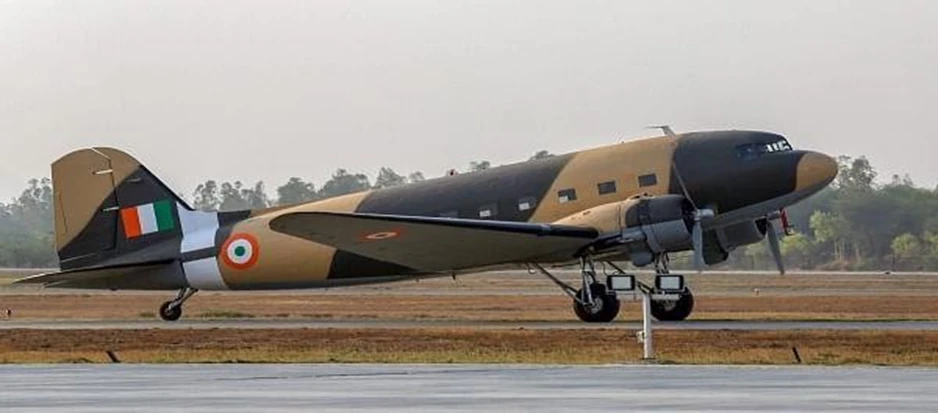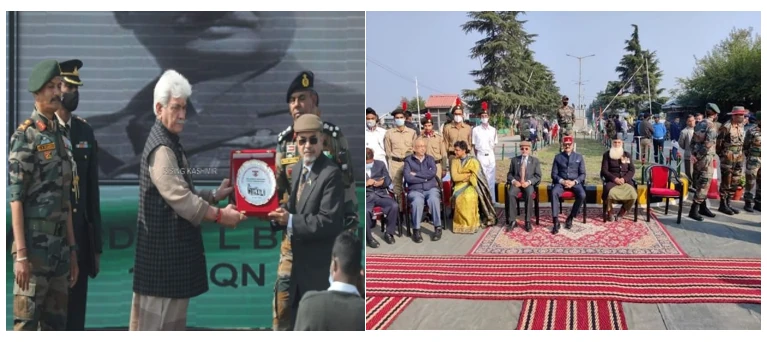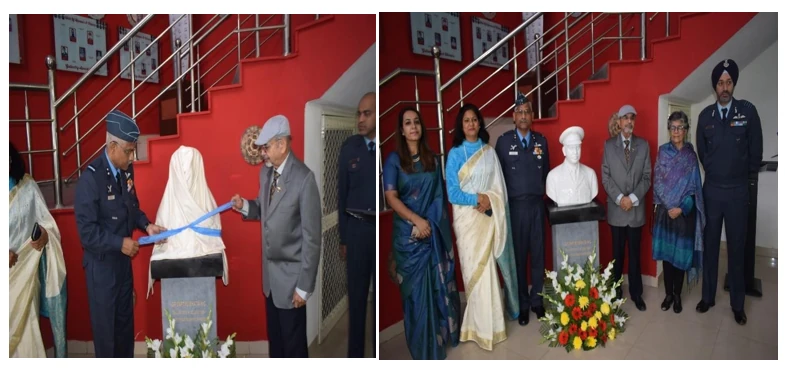12 Squadron and its linkages with Group Captain KL Bhatia, VrC, and The Infantry Day
12 Squadron of the Indian Air Force (IAF) popularly known as ‘The Striking Yaks’ was raised on 1 Dec 1945 and located in Agra. The Squadron was assigned to Central Air Command on its raising in 1966 and has the unique honor of participating in air operations in all the wars with Pakistan since 1947 involving air, land, and airdrop of troops, equipment, supplies, and support or augmenting special operations forces. In the Kargil War, the IAF played a limited role and the transport aircraft flew 3427 sorties constituting 44.9 % of the total air effort in this war.
The 12 Squadron was the last Royal Indian Air Force Squadron raised during the Second World War. They initially operated the Spitfires under Squadron Leader Haider, who migrated to Pakistan following the partition of the country. Soon afterward, the Squadron was scheduled to re-equip with the Mosquito fighter- bombers, but since the Mosquito was withdrawn from service, the Squadron was re-designated as the ‘Transport Squadron’ equipped with the C-47 Dakotas. Squadron Leader KL Bhatia was posted to 12 Squadron in January 47 as the Flight Commander when the unit converted to Dakotas. In May 47, when the RIAF decided to convert one of its Squadron to a second Transport Squadron, he was posted to the newly converted 6 Squadron as its Commanding Officer (CO) but his stint as the CO did not last long due to the partition as 6 Squadron was allocated to newly created Pakistan and all its personnel who opted for India, including Squadron Leader Bhatia were airlifted in August 47 to independent India. Meanwhile, after the partition, the 12 Squadron stayed with the Royal Indian Air Force (RIAF) and came under the command of Wing Commander KL Bhatia, who had returned from Pakistan. Certainly, his experience flying Atlantas, Blenheims, and Hudsons, and his previous stint as Flight Commander, had played an important part in his selection to command the IAF’s only transport that distinguished itself in the 1947-48 J&K Operations.
1947-48 Kashmir Operations
The RIAF lost many permanent bases, squadrons, and other establishments as a result of the division of the country. It had virtually no breathing space to recover from the surgery that had accompanied the partition before it was called to action in 1947-48 J&K Operations. RIAF evacuated a large number of personnel from newly created Pakistan.
On October 47, tribal raiders, clothed, fed, and armed by Pakistan with Pakistani army officers leading them raided Kashmir. On 26 October the Maharaja of Kashmir signed the Instrument of Accession as per the requirements of the partition process and pleaded for Indian military help. The lone transport Squadron under the command of Wing Commander KL Bhatia was not to be left behind. He piloted the very first Dakota aircraft DC-3 VP 905 into the Kashmir Valley on 27 October 47, airlifting 18 jawans of 1 Sikh under their CO, Lt Col Diwan Ranjit Rai. Both the officers in their own ways became legends thereafter. Late Lt
Col Rai was awarded the country’s first Maha Vir Chakra (MVC) posthumously while the 12 Squadron got the highest number of decorations in 1948 War – 12 Vir Chakras including Wing Commander KL Bhatia as well. Ever since the 27th of October is celebrated as Infantry Day. If this flight had NOT been undertaken, defenses in Srinagar/Badgam would have been further threatened, defending whom, the brave heart Major Som Nath Sharma of 4 Kumaon (my Regiment) was awarded the country’s first Param Vir Chakra (PVC) posthumously.
12 Squadron, in the course of its regular casualty evacuation and transport duties, airlifted 25-pounder field guns to Poonch and also ran bombing sorties with their trusted Dakotas. They also flew the first Indian Army troops to Leh, which was the first aircraft to land at Leh, and bombing sorties in support of the army with the bombs being rolled out of the cargo bay by the aircrew under the dynamic dare-devil leadership of Air Commodore affectionately called Baba Mehar Singh.
On 21 March 1948, the Dakota DC-3 VP 914 got shelled by the Pakistani artillery while being flown by Wing Commander KL Bhatia while carrying ammunition to the besieged Indian Army garrison in Poonch while landing. The aircraft was quickly unloaded of its 25-pounder gun and having become unserviceable grounded and the hulk of the aircraft would be seen for decades on the Poonch airstrip before it was finally scrapped. Despite the tail fin being blown off, Wing Commander K L Bhatia managed to abort the take-off. This mission was one of its kind. The much-needed ammunition and supplies enabled the Indian army to defend Poonch from the enemy. For his daredevil bravery, Group Captain KL Bhatia was awarded Vir Chakra and his citation read as follows-
‘Group Captain Karori Lal Bhatia (1605) commanded No.12 Squadron from the early days of the Operations in Kashmir. As a Commanding Officer of the Transport Squadron, he shouldered the heavy responsibility of training his pilots for operations in the mountainous terrain of Kashmir, landing and taking off from hastily prepared airstrips and flying in vital supplies of rations, stores, and ammunition to the besieged garrison located in places like Poonch, etc.
He always displayed the highest order of leadership, and thus was an example to all his Squadron Pilots. He exhibited extraordinary courage and exemplary devotion to duty when his aircraft was damaged by enemy fire while landing at Poonch and by his prompt action and saved the lives of the other members of the aircrew and passengers in the damaged aircraft.
For the outstanding services rendered by him during the Kashmir Operations, he was awarded the Vir Chakra’.
12 Squadron, RIAF though equipped with the venerable Douglas Dakotas, had the distinction of flying many of the legendary flights that saved Kashmir for India. Additionally, several Dakotas of civil operators also helped in the war effort. Nearly 75 years after the operations, it is now possible to piece together the identities of the aircraft involved in the Kashmir Operations.

Restored Dakota aircraft gifted to IAF
It was a matter of GREAT pride for the 12 Squadron and Bhatia clan that the restored Dakota DC-3 VP 905 in the UK joined the IAF on 4 May 2018 in a grand induction ceremony at Hindan Air Force station, more than four decades after the aircraft fleet was phased out following an illustrious service record. The key to the aircraft was received by the then Chief of Air Staff Air Marshal BS Dhanoa from Air Commodore (Retd) MK Chandrasekhar whose dynamic son and Rajya Sabha MP(now Minister of State for IT) Rajeev Chandrasekhar bought and restored the aircraft. This solemn and nostalgic ceremony was attended by Mr Ranjeet Bhatia, the only surviving son of legendary Group Captain Bhatia, VrC.

At the end Oct 2021, the Honourable Lieutenant Governor of Jammu & Kashmir Manoj Sinha, and the GOC 15 Corps honored the heroes and saviors of the 1947-48 Pakistani-led War and Mr Ranjeet Bhatia s/o late Group Captain KL Bhatia, VrC was presented with memento.

The Bust Unveiling Ceremony

On 1 Dec 2021 on the 76th-anniversary function of the 12 Squadron in Agra, where Mr& Mrs RanjeetBhatia were invited, a bust of late Group Captain KL Bhatia, VrC was unveiled both by Air Commodore SK Verma, Air Officer Commanding (AOC) 4 Wing and Mr RanjeetBhatia. It was a great moment for 12 Squadron to honor its old air warrior and CO Group Captain KL Bhatia, VrC, and a matter of Pride for the Bhatia clan. Mrs VeenaBhatia, presented Mrs Verma the AOC‘s wife with a donation of Rs 5000. In an earlier similar function a couple of years back, Ranjeet had presented the Vir Chakra medal of his distinguished flier father to 12 Squadron which finds a place of pride in the 12 Squadron along with the unveiled bust in the Unit’s Museum. I am sure, my story of 12 Squadron and Group Captain KL Bhatia, VrC will inspire generations to come while I stop my pen with this short poem on an unknown warrior fighting in the barren fields and snow of the Poonch garrison-
‘Hold fast to dreams, For if dreams die,
Life is a broken-winged bird That cannot fly.
Hold fast to dreams, For when dreams go, Life is a barren field, Frozen with snow.
Langston Hughes
